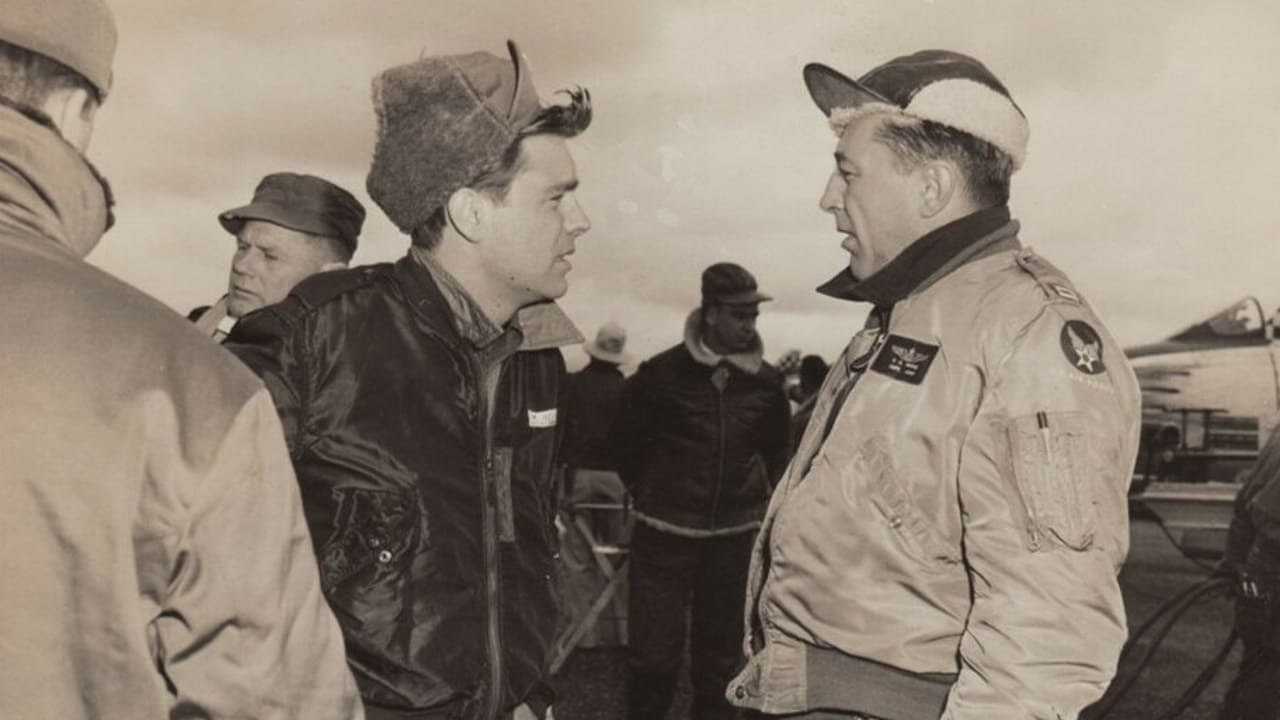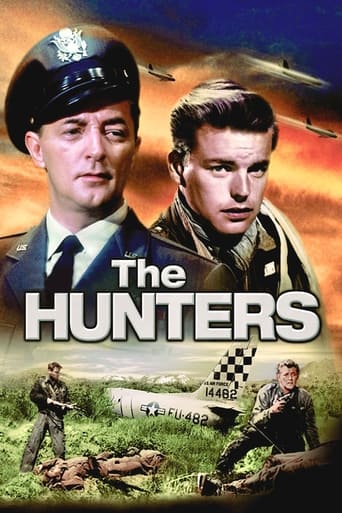Interesteg
What makes it different from others?
Borgarkeri
A bit overrated, but still an amazing film
Teddie Blake
The movie turns out to be a little better than the average. Starting from a romantic formula often seen in the cinema, it ends in the most predictable (and somewhat bland) way.
Asad Almond
A clunky actioner with a handful of cool moments.
BigBobFoonman
This is a pilot's movie--better yet, a pilot with a sense of history and a love of European blondes.....Even sexier than the redoubtable May Britt, the F-86 is given great coverage and detail in what is generally a good war film. The F-86 arrived just in time to save the U.S. Air Force and Naval Air Force from the Mig 15 and 17, probably the most dangerous aircraft faced by the U.S. up to that time.The Migs were chewing up the old straight wing fighters the Navy and Air Force were using, and taking a huge, and strangely under-reported toll on the B-29s that were bombing North Korea. Their losses were so bad that the missions were ended until a viable U.S. jet could be mounted against the Mig. The F-86 was that jet.I was amazed at the number of jet fighters arrayed in the skies above California for the battle sequences. A large contingent of Republic F-84Fs were painted green and sported the red star of the North Korean Air Force. Anybody who knew airplanes saw this inaccuracy, but it did little to detract from the generally very good combat scenes. That is the prime advantage of CGI, today.....they can create a squadron of Mig 15s for a fraction of the cost to attempt to field analog substitutes.The only problem with CGI is the movement of the CGI generated airplanes---it is too stiff, and the turns they show these planes making, especially the prop fighters created in Michael Bay's "Pearl Harbor", the turns and the speeds are way too steep and fast, and have no liquidity of actual movement. Thus the analog dogfights in "The Hunters" were mesmerizing, and quite beautiful."The Hunters" is a fine piece of aviation history, of a little-known and understood war. It was the first all jet war of our time.....fast and very deadly. I continue to wonder, as Fredric March does at the end of a better Korean War movie, "The Bridges at Toko-Ri", ....Where do we get such men....?"
secondtake
The Hunters (1958)Planes, Yes, And a Battle Between Two WarsThe provocatively titled The Hunters is mostly routine, patriotic stuff with some small twists of plot and motivation to keep it interesting. The general tone and the general outcome are givens. There are two halves to the movie. The air-to-air combat, which is exciting if you like that kind of action, and well filmed, and a human plot which lopes along with little consequence. This human half is is filmed so well, you can watch it all and soak up the sets and framing and the gently moving camera scene after scene. It's a good example of a CinemaScope production using the wide wide look, edge to edge. The most beautiful sections are set in civilian Japan, which is an interesting emphasis for a Korean War movie. There are some pretty night shots that have great atmosphere, filled more with charcoal colors than inky black shadows. The brighter interior sets are really stunning in their horizontal sweep and photographed with a kind of professionalism that's easy to take for granted--conservative, beautiful camera-work. Add a little moment here and there, like the longing in the woman's look after she moves to the door 14 minutes in, and you have a hint of missed opportunity. And I don't just mean Mitchum's. I know other people will like the dogfights and military stuff, and if you do, check this out. It's not at all corny or clumsy, but it all looks too much same to me, even if I worry a little about who will get shot down next. A little. Notice how the movie gets far more compelling in the last half hour of fighting on the ground, looking more like WWII. And still filmed beautifully.Significance? Actually, yes. One serious theme throughout is weighing the small Korean Conflict against World War II. Mitchum, a grave, no-nonsense veteran from the earlier war, is not only older and more experienced, he has the credentials of the real thing. He's fighting in Korea because it's the only war going on, and he's a soldier. He has the nickname the Ice Man, but the name feels patched on so the movie can show he really has a heart underneath his steely reserve. It's a paradigm for a great kind of man, I think, and an attractive one even when oversimplified. By contrast, the young pilots are casual and wisecracking, lacking discipline and any sense of commitment, mostly because their war doesn't demand it. One of them (played by Robert Wagner) is so cocky we know he's covering his cowardice. Another is an alcoholic, and his beautiful, lonely wife gets a little quality time with Mitchum, who isn't above sneaking something past one of his young colleagues (she's the little known Swedish actress, May Britt, who later married Sammy Davis, Jr.). Anyway, Mitchum makes good in the end. They all do, those still alive.Underlying all this is the way the Korean War in its dubiousness made these men less substantial, somehow, compared to the men formed by WWII. It's a kind of Generation X syndrome, and it feels real, these Korean War Americans driven mostly by indifference, ultimately distorted by the weird fact that they needed something bigger and more meaningful to react to. It's only after some thinking about it do you realize that Mitchum's strength of character might not be a result of WWII, after all, but of some innate sense of being a fighter. He's not looking for a cause, but for a war. In this movie, he gets a little of both.
vitaleralphlouis
Now in DVD, THE HUNTERS is about the US Air Force during the Korean War; more exactly about a love triangle involving two pilots, and one man's wife. This 1957 movie --- like many films made back when Hollywood was patriotic --- featured real life World War II heroes both on screen and behind the cameras.With most of the focus on the in-air combat and personal relationships on the ground, very little is devoted to what the Korean War was all about. That's too bad, but it made sense in 1957 as there were simply no anti-war advocates. I was in school at that time and I can recall absolutely no anti-war talk at school, at home, on the air, or in the press. Any person doing so would have been considered a traitor and rejected on a social level, if not punched around a few times. We all knew the USA and other countries were fighting not just North Korea but Red China and Stalin's Russia; testing our mettle on Korea's soil. I knew many slightly older guys who went into combat. Not one ever said anything against their task, not during the war or after. It was a tough war, certainly compared to Iraq, and America was losing it for month-after-month until the Inchon Invasion turned it around. With nuclear attack a real possibility, and both Russia and China led by sociopaths who murdered millions of their own people, concerns were severe and everyday.I originally saw this at the World Premiere held at Washington's finest ever movie palace, Loew's Capitol, with Robert Mitchum, Robert Wagner, and the US Air Force Band on stage.
James Hitchcock
Apart from "M*A*S*H" (and even that is, to many people, better remembered as a TV series than as a film) there are not too many well-known Korean War films. I had never heard of this one, which details the part played by the US Air Force in that conflict, but I caught it when it was shown on British television last week.I note that one reviewer entitled his review "A must see for jet air-to-air combat enthusiasts". Whereas his review was, in fact, very helpful in terms of explaining the historical background to the film, that title did make me think "What about the rest of us? What does the film have to offer the average viewer, or even the average film buff, as opposed to the military aviation buff?" I suppose part of the answer to that question is that the film tries to be a character study of men at war. Apart from the military action in which American pilots take on the MiGs of the Chinese air force, the film also charts the relationships between squadron commander Major Cleveland Saville and two of the men under his command, Lieutenant Edward Pell and the depressive, heavy-drinking Lieutenant Carl Abbott. In addition, a romance develops between Saville and Abbott's glamorous Norwegian wife Kristina, who feels neglected by her husband.There are similarities between this film and "The War Lover" from four years later. That film was about the Second World War, but also starred Robert Wagner (who here plays Pell) as a young Air Force pilot who comes into conflict with his superior officer (played in that film by Steve McQueen). Like "The Hunters", "The War Lover" features a love-triangle involving that superior officer and one of the men under his command. There is, however, a difference. In "The Hunters" Saville, played by Robert Mitchum, is supposed to be cool and unemotional (he has won the nickname "The Iceman"), whereas Pell is a brilliant pilot but hotheaded and impulsive. In "The War Lover" it is exactly the other way round. Wagner's character, Lieutenant Bolland, is the conformist, by-the-book flier, whereas his superior, Captain Rickson, is the unorthodox but brilliant rebel against authority.Another difference between the two films is in the balance between the combat scenes and the scenes set on the ground. The air combat scenes in "The Hunters" are indeed very well done, far better than anything in "The War Lover" and the best that I have seen in any film of this period. Indeed, they can stand comparison with similar scenes in modern films, even though there were no computer-generated effects available to film-makers in the fifties, and are the main reason why I have given the film an above-average mark."The Hunters", however, is a much less impressive film when it leaves the skies and comes down to earth. The scenes at the end when Saville and Pell are trying to rescue Abbott, who has been shot down over enemy-held territory, are no more than routine war heroics. "The War Lover" was, on the human level, a powerful emotional drama, the main interest of which lay in the changing dynamics of the triangular relationship between Rickson, Bolland and their mutual love-interest, Daphne. In "The Hunters", by comparison, the romance between Saville and Kristina is perfunctory and unconvincing. The personality clash between Saville and Pell, moreover, is more apparent than real. Saville's nickname of "The Iceman" is largely undeserved. An officer who seduces a brother-officer's wife and who keeps discipline by punching on the jaw any subordinate who gets out of line (as Saville does to both Abbott and Pell) is hardly icy.When I reviewed "The War Lover", I stated that it may not be a particularly gripping war adventure but it is certainly gripping when seen as a human drama. "The Hunters", by contrast, has some great action scenes, but as a human drama it is unconvincing. 6/10

